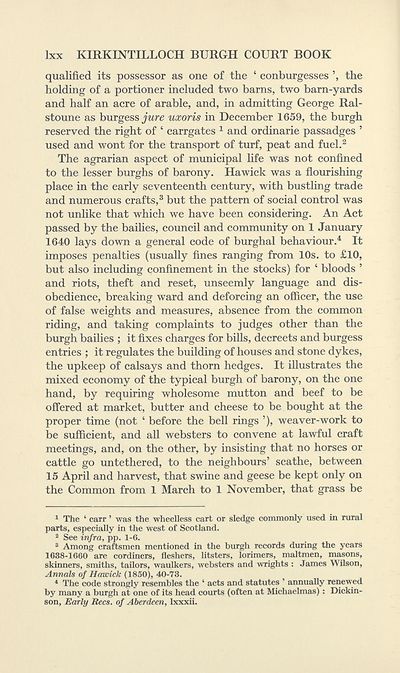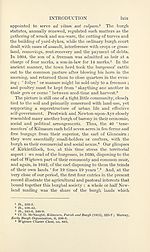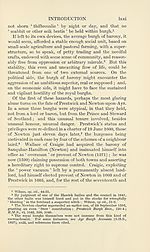Series 3 > Court book of the Burgh of Kirkintilloch 1658-1694
(77) Page lxx
Download files
Complete book:
Individual page:
Thumbnail gallery: Grid view | List view

Ixx KIRKINTILLOCH BURGH COURT BOOK
qualified its possessor as one of the ‘ conburgesses the
holding of a portioner included two barns, two barn-yards
and half an acre of arable, and, in admitting George Ral-
stoune as burgess jure uxoris in December 1659, the burgh
reserved the right of ‘ carrgates 1 and ordinarie passadges ’
used and wont for the transport of turf, peat and fuel.2
The agrarian aspect of municipal life was not confined
to the lesser burghs of barony. Hawick was a flourishing
place in the early seventeenth century, with bustling trade
and numerous crafts,3 but the pattern of social control was
not unlike that which we have been considering. An Act
passed by the bailies, council and community on 1 January
1640 lays down a general code of burghal behaviour.4 It
imposes penalties (usually fines ranging from 10s. to £10,
but also including confinement in the stocks) for ‘ bloods ’
and riots, theft and reset, unseemly language and dis¬
obedience, breaking ward and deforcing an officer, the use
of false weights and measures, absence from the common
riding, and taking complaints to judges other than the
burgh bailies ; it fixes charges for bills, decreets and burgess
entries ; it regulates the building of houses and stone dykes,
the upkeep of calsays and thorn hedges. It illustrates the
mixed economy of the typical burgh of barony, on the one
hand, by requiring wholesome mutton and beef to be
offered at market, butter and cheese to be bought at the
proper time (not ‘ before the bell rings ’), weaver-work to
be sufficient, and all websters to convene at lawful craft
meetings, and, on the other, by insisting that no horses or
cattle go untethered, to the neighbours’ scathe, between
15 April and harvest, that swine and geese be kept only on
the Common from 1 March to 1 November, that grass be
1 The ‘ carr ’ was the wheelless cart or sledge commonly used in rural
parts, especially in the west of Scotland.
2 See infra, pp. 1-6.
3 Among craftsmen mentioned in the burgh records during the years
1638-1660 are cordiners, fleshers, litsters, lorimers, maltmen, masons,
skinners, smiths, tailors, waulkers, websters and wrights : James Wilson,
Annals of Hawick (1850), 40-73.
4 The code strongly resembles the ‘ acts and statutes ’ annually renewed
by many a burgh at one of its head courts (often at Michaelmas) : Dickin¬
son, Early Rees, of Aberdeen, Ixxxii.
qualified its possessor as one of the ‘ conburgesses the
holding of a portioner included two barns, two barn-yards
and half an acre of arable, and, in admitting George Ral-
stoune as burgess jure uxoris in December 1659, the burgh
reserved the right of ‘ carrgates 1 and ordinarie passadges ’
used and wont for the transport of turf, peat and fuel.2
The agrarian aspect of municipal life was not confined
to the lesser burghs of barony. Hawick was a flourishing
place in the early seventeenth century, with bustling trade
and numerous crafts,3 but the pattern of social control was
not unlike that which we have been considering. An Act
passed by the bailies, council and community on 1 January
1640 lays down a general code of burghal behaviour.4 It
imposes penalties (usually fines ranging from 10s. to £10,
but also including confinement in the stocks) for ‘ bloods ’
and riots, theft and reset, unseemly language and dis¬
obedience, breaking ward and deforcing an officer, the use
of false weights and measures, absence from the common
riding, and taking complaints to judges other than the
burgh bailies ; it fixes charges for bills, decreets and burgess
entries ; it regulates the building of houses and stone dykes,
the upkeep of calsays and thorn hedges. It illustrates the
mixed economy of the typical burgh of barony, on the one
hand, by requiring wholesome mutton and beef to be
offered at market, butter and cheese to be bought at the
proper time (not ‘ before the bell rings ’), weaver-work to
be sufficient, and all websters to convene at lawful craft
meetings, and, on the other, by insisting that no horses or
cattle go untethered, to the neighbours’ scathe, between
15 April and harvest, that swine and geese be kept only on
the Common from 1 March to 1 November, that grass be
1 The ‘ carr ’ was the wheelless cart or sledge commonly used in rural
parts, especially in the west of Scotland.
2 See infra, pp. 1-6.
3 Among craftsmen mentioned in the burgh records during the years
1638-1660 are cordiners, fleshers, litsters, lorimers, maltmen, masons,
skinners, smiths, tailors, waulkers, websters and wrights : James Wilson,
Annals of Hawick (1850), 40-73.
4 The code strongly resembles the ‘ acts and statutes ’ annually renewed
by many a burgh at one of its head courts (often at Michaelmas) : Dickin¬
son, Early Rees, of Aberdeen, Ixxxii.
Set display mode to:
![]() Universal Viewer |
Universal Viewer | ![]() Mirador |
Large image | Transcription
Mirador |
Large image | Transcription
Images and transcriptions on this page, including medium image downloads, may be used under the Creative Commons Attribution 4.0 International Licence unless otherwise stated. ![]()
| Scottish History Society volumes > Series 3 > Court book of the Burgh of Kirkintilloch 1658-1694 > (77) Page lxx |
|---|
| Permanent URL | https://digital.nls.uk/126714087 |
|---|
| Attribution and copyright: |
|
|---|
| Description | Over 180 volumes, published by the Scottish History Society, containing original sources on Scotland's history and people. With a wide range of subjects, the books collectively cover all periods from the 12th to 20th centuries, and reflect changing trends in Scottish history. Sources are accompanied by scholarly interpretation, references and bibliographies. Volumes are usually published annually, and more digitised volumes will be added as they become available. |
|---|


